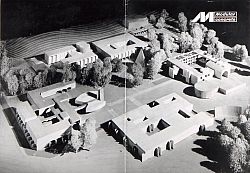
To mark Spence’s enduring contribution to Sussex, art historian Professor Maurice Howard brought together for the first time the University’s own collection of original drawings (some by Spence), models, photographs and artifacts relating to dining and ceremonial at the University to evoke a sense of the early years of Sussex.
The exhibition explored the phases of development, public and press reaction to the scheme, the early use of the buildings and the landscaping of the environs, as well as the buildings’ place in Spence’s distinguished career.
Original research by Professor Howard and by the country’s leading Spence scholar, Louise Campbell of the University of Warwick, brought out the significance of the buildings, while Spence himself will be seen giving his views in archive film as part of the visitor experience. Professor Howard was assisted by art history graduates Sally Johnson and Mike Davy.
Professor Howard said: “I have been involved in many exhibitions for national museums and learned societies, but the chance to work on this show about the historic legacy of buildings at my own university has been an extraordinary experience.
“Working with a team of professional designers has meant that the exhibition looks very beautiful, the objects present a strong sense of artistic merit and yet it is clear they served as the practical means of planning the university’s listed buildings.
“To bring all this together has meant consultation with the country’s leading scholars of Basil Spence, his family and business associates, but also people who knew the university in its early days. I hope that the exhibition will elicit more memories and information since I see this very much as the starting-point of the next stage of valuing the university’s buildings and planning their future.”
The exhibition was partnered by a lecture given by Sussex alumna Dr Campbell and introduced by the architect (son-in-law and practice partner of Sir Basil Spence) Anthony Blee, on Spence, Sussex and the Sixties, on 23 May.
Spence’s modernist vision for a university fit for a brave new world required a bold, innovative concept, but the architect was also sensitive to the beauty of the downland setting and the value of local, traditional building materials.
Spence said at the time: “Bricks and mortar can provide a background that is sympathetic to young and energetic minds which are growing and developing apace.”
The resulting buildings, including Falmer House, the Library, the Arts buildings, the Gardner Arts Centre (now the Attenborough Centre for the Creative Arts), Chichester I and Pevensey I remain at the heart of campus today and became the first 1960s buildings in the country to be listed (Falmer House, in fact, shares Grade I listed status with Coventry Cathedral). Spence’s practice designed 17 buildings in all for the University.


